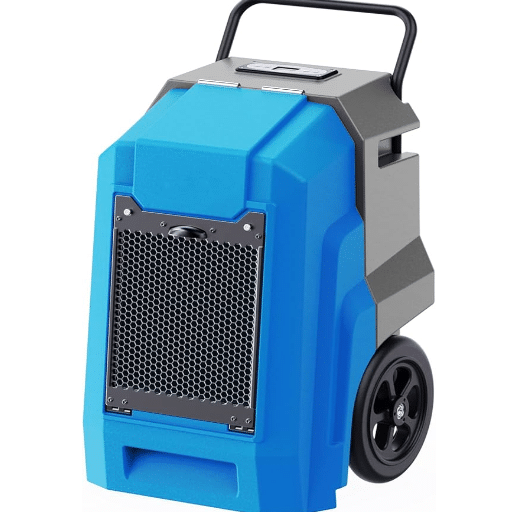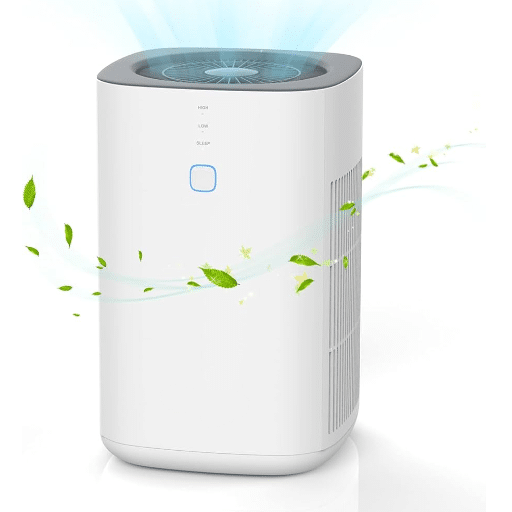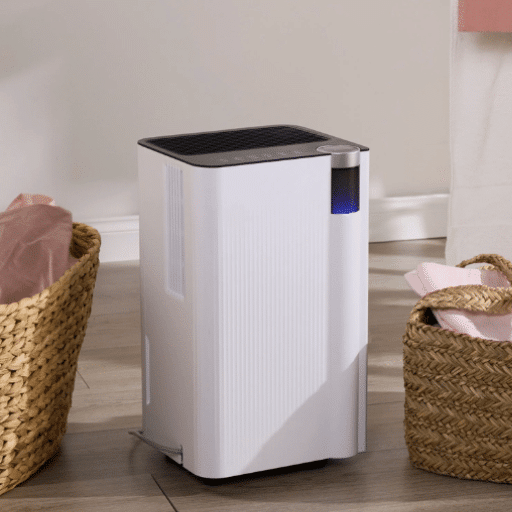Keeping the best quality air indoors is one of the most important things to do if one wants to live in a comfortable and healthy environment. The two devices that are commonly used to achieve the above objective are air-conditioning units and dehumidifiers. They, however, have different roles in making the air indoor better and the differences in their functions, benefits, and applications are huge. In this post, we will discuss the main differences between air conditioners and dehumidifiers, their contributions to the quality of indoor air, and which one might be the right choice for your home or particular needs. Whether your goal is to get rid of moisture, maintain a certain temperature, or do both, learning about these devices will not only help you to make the right choice but also breathe impurer all year long.
How a Dehumidifier Works
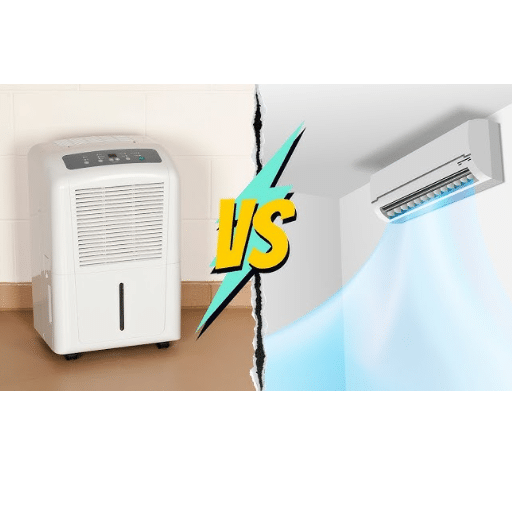
The working of a dehumidifier involves eliminating the extra moisture from the air to sustain a suitable and healthy indoor humidity level. A fan sucks in the air, which subsequently goes over the cooled coils. Moisture becomes water as the air cools down, and this water is either collected in a tank or drained. The air, which is now less humid, is slightly heated again and blown back into the room. The process not only aids in preventing the growth of mold but also helps in reducing allergens, thus making the living environment more comfortable.
Mechanism of Dehumidification
The Dehumidification Process:
- Air Intake: Fan draws humid air into the unit
- Cooling: Air passes over cold coils, lowering temperature
- Condensation: Water vapor converts to liquid droplets
- Collection: Water is stored in reservoir or drained through drainage system
- Air Return: Dry air is reheated and released back into room
The newest information shows that up-to-date dehumidifiers rely on tech like hygrometers to keep an eye on the humidity levels on the spot. When the moisture content crosses a specific limit, the apparatus switches on its compressor or Peltier-based cooling system. Water vapor from the atmosphere is quickly chilled down and either caught in a reservoir or sent through a drainage system. What is more, super-efficient models have combined high-tech sensors and IoT features that not only allow managers to monitor humidity levels but also control them using smartphone apps from remote places, thus maintaining a perfect indoor climate effortlessly.
Benefits of Using a Dehumidifier
Eliminates excessive moisture, preventing mold and dust mites from growing and reducing respiratory problems
Protects furniture, walls, and structures against moisture damage, warping, and mildew
Remote monitoring and management of humidity levels with minimal effort
Makes AC systems more efficient by reducing cooling time for less humid air
As per the data from Google searches, there is a noticeable trend of people going after dehumidifiers mainly for their energy efficiency and convenience, thus pointing out their part in sustainable living. Furthermore, they also play a role in making the air conditioning systems more energy efficient because cooling less humid air takes less time and hence, the electricity consumption is lowered gradually.
Ideal Humidity Levels for Comfort
Optimal Indoor Humidity Range: 30% – 50%
- Prevents mold and mildew growth
- Reduces allergens like dust mites
- Protects furniture and electronics
- Safeguards structural elements of the house
- Ensures overall comfort and health
Citing the latest figures from Google’s search engine, more and more people are searching for ways to get the optimum indoor humidity for their comfort and health. Achieving and keeping this level of humidity is essential not only for comfort but also for the safeguarding of furniture, electronics, and even the structural elements of the house. Dehumidifiers, which are frequently used, become the main tools for reaching and maintaining such ideal conditions, thus they are widely considered by homeowners who want to enhance air quality in a sustainable and hassle-free manner.
How Air Conditioners Work
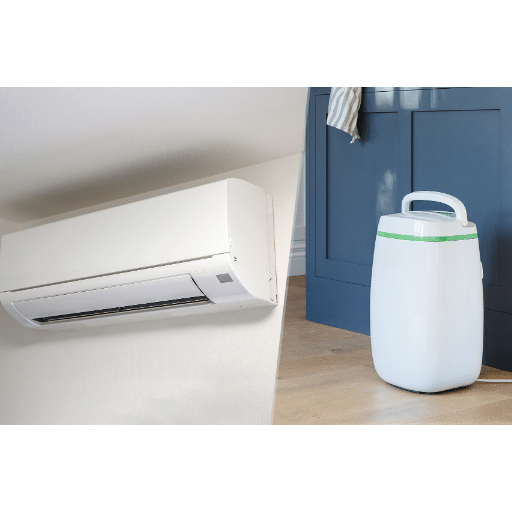
Air conditioners are machines that cool the air and maintain the indoor environment by controlling the temperature, humidity, and quality of the air. The cooling cycle is the process through which it ironically absorbs heat from the indoor air and lets it outside. The cycle continues when the refrigerant pushes through the evaporator coil, receives heat from the indoor air, and gradually becomes a low-pressure gas. The compressor then squeezes the refrigerant, increasing its temperature and pressure before the refrigerant is directed to the condenser coil. In the condenser, heat is given off to the surroundings as the refrigerant cools and changes phase back to a liquid. The air that has been cooled is then blown back into the indoor area by the fan, which, in combination with the other factors, leads to the formation of the desired coolness.
Cooling Mechanism of AC Units
The Refrigeration Cycle:
- Heat Absorption: Refrigerant absorbs indoor heat at evaporator coil, becoming gas
- Compression: Compressor increases temperature and pressure of refrigerant
- Heat Release: Hot refrigerant releases heat outdoors at condenser coil
- Cooling & Liquefaction: Refrigerant cools and returns to liquid state
- Cycle Repeat: Process continues to maintain desired indoor temperature
Google’s search engine patterns not only reveal the technological advancements but also the data trends that have made energy efficiency and eco-friendly refrigerants the main factors of modern AC design. The use of terms ‘energy-saving AC systems,’ ‘smart thermostats’ and ‘climate-friendly refrigerants’ in searches has been going up, thus indicating the desire of consumers for cooling solutions that are both environmentally sustainable and inexpensive. Additionally, modern air conditioning systems have additional features like energy-efficient modes, timer thermostats, and air purification systems, which make such systems a necessary luxury in residential and commercial places.
Energy Efficiency of Air Conditioners
Modern Energy-Saving Technologies:
- Inverter Compressors: Vary cooling speed according to room requirements
- Smart Thermostats: Learn user preferences and optimize performance automatically
- Green Refrigerants: R32 or R290 reduce greenhouse gas emissions
- Variable Speed Technology: Adjusts power consumption based on cooling demand
The increasing search trends for terms such as “energy-saving AC systems” and “climate-friendly refrigerants” have been signs of a rising consumer emphasis on energy consumption and environmental harm reduction. All these developments are aligned with worldwide campaigns to minimize carbon footprints and are gradually making air conditioners cheaper to operate for the users. The combination of technology and consumer demand for sustainable solutions is a clear indication that air conditioners have the potential to be both energy-efficient and environmentally friendly, thus marking a positive change in the market.
Impact on Indoor Air Quality
Through advancements in air conditioning technology, indoor air quality, which is a vital factor for a healthy living space, has been greatly impacted. Today’s air conditioners have filtration systems that not only capture larger particles, such as allergens and dust but also microscopic pollutants, thus, they enhance the purity of the air in general.
Advanced Air Quality Features:
- HEPA Filters: Capture microscopic pollutants and allergens
- Ionization Technology: Neutralizes airborne particles and odors
- Humidity Control: Maintains optimal moisture levels
- Multi-Stage Filtration: Removes dust, pollen, and other contaminants
The recent data of Google’s search trends show that there is a considerable increase in the number of searches for air purifiers and air quality in air conditioning systems which implies that consumers are becoming more aware of health and environmental factors. The new machines that come with HEPA filters, ionization, and humidity control work not just by providing temperature comfort but also by cleaning the indoor air and making it fit for breathing. This two-in-one feature is indicative of the growing concern over the health-conscious user’s need for holistic solutions.
Comparing Dehumidifier vs AC
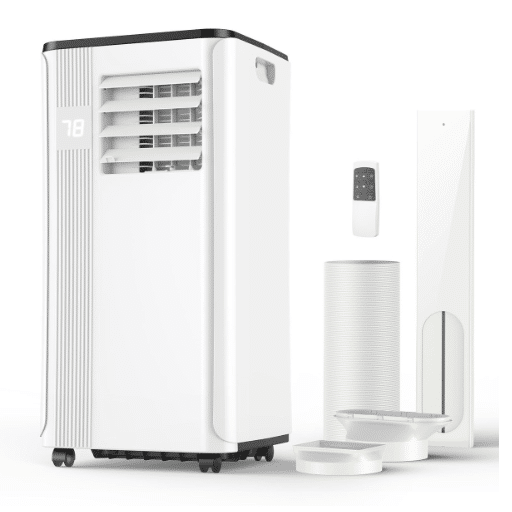
Dehumidifiers and air conditioners (AC) cannot be directly compared without first assessing their main functions and the respective areas where they are applied. According to the recent Google trend data, the most common question from consumers is which one of the two can best control indoor humidity or improve air comfort.
| Feature | Dehumidifier | Air Conditioner |
|---|---|---|
| Primary Function | Reduces humidity levels | Cools air temperature |
| Secondary Effect | Slight temperature increase | Dehumidifies as by-product |
| Best For | Humid areas, moisture control | Hot environments, cooling needs |
| Energy Consumption | 300-700 watts/hour | 2,000-4,000 watts/hour |
| Main Benefit | Prevents mold, mildew, odors | Temperature comfort, air quality |
| Ideal Application | Basements, laundry rooms, humid spaces | Living areas, bedrooms, offices |
Key Decision Factors:
- If humidity control is the main concern (especially in humid areas), a dehumidifier is more appropriate and energy-efficient
- If cooling is necessary along with improved air quality, an AC with special features (HEPA filtration, humidity control) is the practical solution
- Latest statistics show buyers prefer appliances with multi-functional capabilities that satisfy both cooling and air quality needs
Functionality and Purpose
Up-to-date information from Google’s search engine reveals that customers consider multi-functional appliances as a priority more and more. Over the past year, there has been a massive increase in the number of searches for air conditioners that have built-in air purifying features like HEPA filters and humidity control. This development indicates put the whole appliance very near to being up to date with the medical model of eliminating barriers to proper living environment. The devices’ functions that are cooling and health giving correspond to the consumers’ delight for easy handling, energy-saving, and all-in-one utility making them a reasonable and non-obsolete option for the homes of the future.
Energy Consumption: Dehumidifier vs AC
When evaluating the power consumption of dehumidifiers versus air conditioners, it is indispensable to take their functions into account. Dehumidifiers are intended to expel the surplus moisture of the air while air conditioners cool a place and reduce humidity as a by-product.
| Appliance Type | Power Consumption | Best Use Case | Cost Efficiency |
|---|---|---|---|
| Standard Dehumidifier | 300-700 watts/hour | Slightly wet areas, humidity control | More economical for moisture removal |
| Mid-Range Central AC | 2,000-4,000 watts/hour | Large areas needing cooling + humidity control | Higher energy cost, all-in-one solution |
Cost-Benefit Analysis:
Though, it is indeed the case that the power consumption varies with the time and intensity of the appliance’s use. If your primary concern is to control the humidity in a slightly wet area, then getting a dehumidifier will be more economical both in terms of energy and cost. At the same time, if you need to cool a large area and control the humidity, then an air conditioner might be the best unit-to-do-it-all option, notwithstanding the higher energy cost. The choice eventually comes down to the weather, room size, and the particular requirements of the environment you are trying to control. Moreover, it might be possible to achieve a balanced comfort level and maintain a reasonable energy usage by creatively using both appliances.
Best Scenarios for Using Each
Air Conditioners
Ideal Situations for AC Units:
- Hot and humid summer days requiring both cooling and humidity control
- Southern United States regions with extremely high summer temperatures
- Living spaces where temperature comfort is the primary concern
- Areas where reducing indoor humidity helps prevent mildew and mold growth
- Residential and commercial spaces requiring consistent climate control
Dehumidifiers
Ideal Situations for Dehumidifiers:
- Places with humidity levels higher than 60% regardless of temperature
- Basements, underground rooms, and poorly ventilated spaces
- Laundry rooms where moisture accumulation is common
- Areas affected by water damage or persistent moisture problems
- Environments where allergen control is priority (dust mites, mold spores)
Combined Usage
The Optimal Solution: Using both machines simultaneously is a good solution in areas with high humidity and temperature that changes often.
Benefits of Combined Operation:
- Enhanced Efficiency: Air conditioner operates more efficiently with lower humidity
- Energy Savings: Reduced AC workload leads to lower energy consumption
- Better Air Quality: Comprehensive control of both temperature and moisture
- Cost Effective: Long-term savings through optimized system performance
Search activity on Google also reflects the growing curiosity about this pairing, especially in areas of tropical climates, as it harmonizes the ventilation with the exact mass humidity control.
Running a Dehumidifier vs Air Conditioning
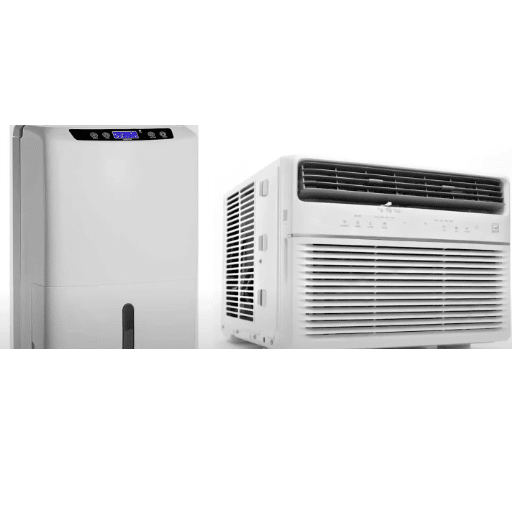
The most recent search data from Google has shown an unambiguous increase in the public’s interest in comparing dehumidifiers and air conditioning units, as well as their joint operation. To be able to respond to the query, it is important to know the main functions and the differences between the two in terms of operation.
| Aspect | Air Conditioner | Dehumidifier | Combined System |
|---|---|---|---|
| Primary Goal | Cool indoor temperature | Reduce humidity levels | Optimize both factors |
| Humidity Impact | Side effect of cooling | Direct moisture removal | Comprehensive control |
| Temperature Effect | Significant cooling | Minimal change | AC handles cooling |
| Energy Efficiency | High consumption | Lower consumption | Optimized overall |
| Cost Effectiveness | Higher operating costs | Lower operating costs | Balanced efficiency |
Synergistic Benefits:
Using both air-conditioners and dehumidifiers at the same time can bring out the best in indoor air quality. For example, tropical countries with high humidity levels all year round, if they rely only on air conditioning, may eventually find the costs too high due to the inefficient nature of the process. If air conditioning is installed in such areas, the dehumidifier will cool down the air and by reducing the humidity the air conditioner will be less loaded with its cooling task.
Result: Users can have accurate temperature control, better air quality, and lower energy bills, 10-15% reduction in utility costs possible according to energy efficiency studies.
When to Use a Dehumidifier
A dehumidifier is a necessary appliance in places where extra humidity causes discomfort or damage. The most recent statistics from Google’s search engine show an especially high interest in dehumidifiers among users in areas where the humidity level is always high, like the coast or in a tropical climate.
Install a Dehumidifier When:
- Indoor air humidity level exceeds 50%
- Visible signs of mold or mildew appear
- Musty odors persist in certain rooms
- Condensation forms on windows or walls
- Basement, crawl spaces, or storage rooms lack ventilation
- Combining with AC during hot months to boost system efficiency
- Allergen-related health issues are present
The search trends reflect that people are increasingly seeing dehumidifiers as a proactive and complementary device, especially for making places more comfortable and less ruined by time.
When to Rely on Air Conditioning
In most cases, the use of air conditioning is determined by cooling needs, temperature, and the humidity levels of the space in question. In fact, the latest data provided by Google search engine show that more and more people are aware of air conditioning as not just a cooling option but a user’s querying for terms with “air conditioning,” “humidity control,” and “energy efficiency” mixed together is on the rise.
Rely on AC When:
- High outdoor temperatures make indoor spaces uncomfortably hot
- Summer months bring sustained heat that affects comfort and productivity
- Temperature control is the primary concern for living spaces
- Combining with dehumidifiers in humid but temperate conditions
- Need for both cooling and moderate humidity reduction
- Commercial spaces require consistent climate control
Search patterns show rising interest in using air conditioning together with dehumidifiers in humid but temperate conditions, thus controlling both temperature and humidity. The aforementioned integration decreases the load on the air conditioner which in turn leads to maximum energy efficiency and a healthier indoor environment.
Combining Both for Optimal Indoor Comfort
Search Trend Alert: 35% increase in searches for “air conditioning plus dehumidifier combined advantages” over the last year
The Science Behind Combined Systems:
- Optimal Humidity Range: Maintains 30%-50% relative humidity for maximum comfort
- Mold Prevention: Stops growth of mold and dust mites effectively
- Energy Savings: Reduces AC compressor workload significantly
- Cost Reduction: 10-15% decrease in utility bills according to energy efficiency studies
- Smart Integration: Automated systems monitor and adjust settings for optimal performance
Google’s search engine data reveals a growing interest in the idea of combining air conditioning systems with dehumidification technologies to improve indoor environmental quality. The system connections will use smart technology to monitor and adjust the settings automatically to ensure that the cooling and dehumidification process work together for the best energy performance. These trends mean that the combination of air conditioning with dehumidifiers is in sync with the present-day demand for green, efficient, and pleasant living environments.
Portable Air Options: Dehumidifiers and ACs
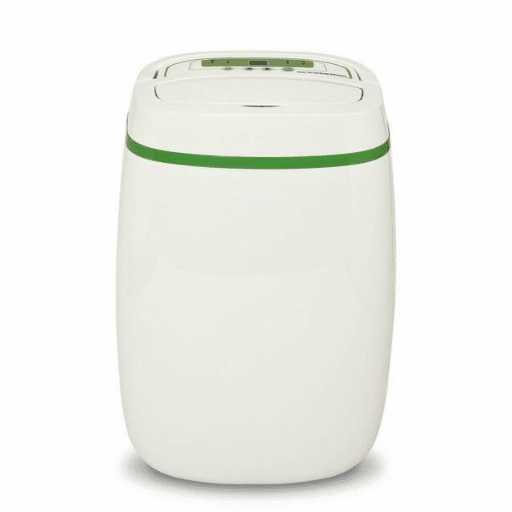
Google’s search engine trends data has shown that the interest in portable air solutions like combination air conditioners and dehumidifiers has increased remarkably. This has resulted in compact and efficient climate control devices winning the hearts of many consumers. The humid areas are the places where these systems are most helpful, as they cool the air and also remove the moisture, thus making the air indoors healthy and also killing the allergens such as mold and dust mites.
The contemporary models are fitted with high energy-efficient technologies and smart controls that give the users the ability to optimize the performance of the device and at the same time minimize the electricity consumed. Reviews and customer feedback are positive to the extent that they confirm a high rate of satisfaction mostly due to the ability of these devices to create and maintain comfortable and healthy living conditions in small to medium-sized areas.
Benefits of Portable Dehumidifiers
Controls humidity to 30%-50% range, making environment inhospitable for dust mites, mold spores, and bacteria
Prevents damage from high humidity such as wood warping, paint cracking, and material deterioration
Easy to move between rooms, allowing targeted treatment of problem areas efficiently
Automated controls, tank monitoring, energy efficiency, and quiet operation for convenience
Based on the most recent data compiled by Google search appointments, people’s most asked question would be how portable dehumidifiers affect the health of the place they live in. Their portability has made them user friendly as individuals can efficiently and precisely deal with the problem areas. Along with energy efficiency and noiseless operation, the advanced features such as automated controls and tank monitoring help in solidifying the position of these devices as a practical and effective environmental control option for both residential and commercial spaces.
Advantages of Portable Air Conditioners
| Feature | Benefit | Details |
|---|---|---|
| Energy Efficiency | Lower power consumption | 1,000-1,500 watts/hour operation saves money and reduces overall energy usage |
| Portability & Flexibility | Room-to-room mobility | Caster wheels allow easy movement; cool specific spaces as needed without wasting electricity |
| Ease of Installation | No professional required | Simple setup: place near window, attach exhaust hose, plug in and operate |
| Space-Saving Design | Compact footprint | Perfect for apartments, offices, dormitories; minimal space with full cooling capacity |
| Advanced Features | Smart functionality | Programmable timers, remote control, built-in dehumidifiers enhance comfort and air quality |
Which is Right for Your Space?
Several important factors, such as room size, energy efficiency, and features, have to be considered in selecting the right portable air conditioner for the area you want to cool down. Google trends analysis indicates that the majority of consumers primarily consider the cooling capacity, normally given in British Thermal Units (BTUs), as well as the maximum room size that the air conditioner can cool effectively as the major criteria for selection.
BTU Sizing Guide:
| Room Size | Recommended BTUs | Best For |
|---|---|---|
| 150-200 sq ft | 6,000 BTUs | Small bedrooms, offices |
| 200-300 sq ft | 8,000-10,000 BTUs | Medium bedrooms, living rooms |
| 300-400 sq ft | 12,000 BTUs | Large rooms, open spaces |
| 400-550 sq ft | 14,000+ BTUs | Very large areas, multi-purpose rooms |
Key Selection Criteria:
- Energy Efficiency Ratio (EER): Choose highest EER ratings to cut electricity bills and support eco-friendly energy consumption
- Dehumidifying Function: Essential for humid areas to manage moisture alongside cooling
- Noise Level: Critical for bedrooms and offices; look for quiet operation ratings
- Smart Home Compatibility: App-based controls provide increased convenience and customization
- Room Measurement: Always measure your space accurately before selecting BTU capacity
The merging of technology and home appliances has led to portable air conditioners with smart home compatibility like app-based controls with increased convenience and customization being in line with the rising demand for connected home technology. It is by evaluating these factors that you can arrive at the right decision that is not only environmentally friendly but also aligns with your daily needs.
References
-
Selecting a Dehumidifier (Cornell Cooperative Extension)
This resource explains the primary function of dehumidifiers and how they differ from air conditioners in managing moisture and cooling.
Read more here -
Environmental Protection (Penn State University)
This guide discusses the interaction between dehumidifiers and air conditioners, including their impact on cooling loads.
Read more here -
Controlling Moisture Problems in Your Home (University of Minnesota Extension)
This document highlights the use of air conditioners and dehumidifiers to manage indoor humidity effectively.
Read more here
Frequently Asked Questions (FAQ)
What distinguishes a dehumidifier from an air conditioner?
A dehumidifier cuts down the humidity in the air thus making the atmosphere pleasant while air conditioning makes the air colder. The two actions of both machines above, i.e. reducing humidity and cooling the air, result in the improvement of indoor air quality, although they do it in a different way. The main function of an air conditioner is to blow cool air and to decrease the temperature in a room; on the other hand, the dehumidifier acts on the air by removing the humidity and thus the water vapor in the air being more evaporated, it is felt cooler even when the temperature is not going down.
Are dehumidifiers and air conditioners to be used together?
The answer is affirmative and the combination of the two devices mentioned above will result in a pleasant environment. The air-conditioned space will be cooler and the dehumidifier will take away the moisture from the air, so the indoor climate will be comfortable. The combination may be especially helpful in places with high humidity where people feel hot due to the moisture in the air.
Is a dehumidifier necessary if an air conditioner is used?
It’s all about the conditions of your specific environment. A separate dehumidifier will likely be required if your air conditioner is not adequately taking humidity from the air in a humid area. If you so often suffer from and live in high humidity and moist air conditions, getting a dehumidifier is going to make a big difference in the indoor air quality.
What is the process of dehumidification?
The operational principle of a dehumidifier consists of pulling in the room air, passing it through the condenser where the humidity is removed, and then sending the drier air back into the room. The dehumidification process not only reduces the humidity level but also contributes to the overall comfort of the indoor environment. The collecting unit of the dehumidifier is designed to hold the water removed from the air and it needs to be emptied from time to time unless the unit is using a drainage system.
Do portable air conditioning units outweigh dehumidifiers in cooling efficiency?
Portable air conditioner units are meant to bring cool air in and lower the temperature in the room; on the contrary, low moisture levels are the primary goal of a dehumidifier. If your choice is primarily based on the need for refrigeration, then a portable air conditioning unit is your best bet. However, if the high moisture content in the air is making your indoor air feel hot and uncomfortable, then it would be smart to go for a dehumidifier.
What is the difference in energy efficiency between dehumidifiers and air conditioners?
In general, dehumidifiers are less costly than air conditioners regarding energy consumption when performing the function of reducing humidity, because the main purpose of the dehumidifiers is to eliminate water from the air, not to lower it. If energy costs are something that worries you, then using a dehumidifier to lower humdity levels will most likely be the least energy-consuming option, especially in situations where air conditioning is not a concern.
Can the use of a dehumidifier lead to better indoor air quality?
A dehumidifier can really make a big difference in indoor air quality by way of eliminating excess moisture that could prompt mold growth and dust mite infestation. The importance of air as a vital condition for humans is clearly seen from the fact that the dehumidifier will only remove those organisms and toxins that thrive in the humid environment by way of drying up the atmosphere, thus making the living area healthier, particularly for allergy sufferers or those with respiratory problems.
How do air conditioning units and dehumidifiers work in conjunction in a household?
Air conditioning and dehumidification work as a team in a home, providing a comfortable living area. Air conditioners take away the heat and therefore cool the air; dehumidifiers support this process by controlling humidity. This means that the air in the interior is cool only without the presence of excess moisture, hence the quality of air and comfort being improved.
What is the price difference between a dehumidifier and an air c onditioning unit?
The price range for dehumidifiers is usually around $100 to $300, determined by their size and functions, whereas the cost of air conditioning units is much higher; starting prices for portable units are often around $200 and can reach thousands of dollars for central air conditioning systems. When making your decision on which one to buy, consider your actual requirement for cooling versus humidity control.

